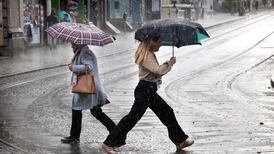One of the disadvantages of the convenient and spacious media centre in Croke Park is that there’s no need to return to the office after matches in the stadium. That walk used to bring us past the Dergvale Hotel in Gardiner Place and temptation beyond breaking point frequently meant quick pints to gather ourselves.
The premises has a big place in GAA history so it always felt appropriate that it should also have a place in the first draft of that history, which would be rattled out later in the afternoon.
This was admittedly a long time ago, pre-internet and when such work practices didn’t sound as outdated as sticking hot pokers into pots of ale.
Owners Gerry and Nancy Nolan could be forgiven for confining their interest in the GAA to the big match-day experiences, which have previously been compared to re-enactments of Rorke’s Drift, as waves of spectators fall on the premises but they have also proved conscientious curators of the hotel’s history.
For a couple of years in the late 19th century, 4 Gardiner Place was home to GAA founder Michael Cusack’s family and his academy, a school specialising in gearing candidates for the Victorian civil service examinations.
In this he was particularly successful. On January 5th 1884, The Irishman published the results of those attending his academy and stated, “Mr Cusack is the only grinder in Dublin who secured a pass at any of these examinations”. He was reported to be earning £1,500 per annum during the heyday of his school.
A plaque marking the site of the academy was unveiled on the weekend of the Centenary All-Ireland hurling final in 1984 – ironically the last time an All-Ireland wasn’t played at nearby Croke Park – but its significance goes beyond that.
Brother Seán MacNamara is the most zealous keeper of this flame. Happily still with us after his 94th birthday last month, he published The Man from Carron 15 years ago on the centenary of Cusack’s death and has lectured widely on the subject.
His research turned up, amongst other things, an original diary. The twin emphases of this work are to reinforce the central importance of Cusack to the both the GAA, which he founded, and the cause of Irish nationhood as well as to convert everyone to the view that the GAA’s birthplace was not Hayes’s in Thurles but another hotel, the Dergvale.
In 2010 the Dergvale unveiled a memorial to its famous previous occupant and screened a DVD, which was scripted and presented by Brother MacNamara. He pointed out that the letters inviting people to attend the inaugural meeting in Thurles on 1st November 1884, were sent from Gardiner Place on October 27th.
Croke Park is the most visible symbol of the GAA but in MacNamara’s view the stadium, rather than one of its stands, should have been named after Cusack but he has accepted that this is not going to happen at this stage. Since the centenary of the founder’s death, his presence has been amplified by the installation of Paul Ferriter’s fine sculpture just outside the GAA Museum.
November is the month for these reminiscences. Last Monday was the 137th anniversary of the GAA’s foundation in Thurles or its formal establishment to give Brother MacNamara’s case its due. Later this month will be the 114th anniversary of Cusack’s death.
Another less remarked on November event is the erection of a memorial in Dublin’s Deansgrange cemetery in the GAA’s 125th anniversary year of 2009. It was to commemorate Thomas St George McCarthy, a former rugby international and policeman, who was also one of those who attended the meeting in Hayes’s Hotel.
McCarthy is also remembered in the eponymous trophy presented for an annual match between the Garda Síochána and the PSNI. Largely forgotten up until the 125th celebrations, his cause was taken up by former Armagh captain Jarlath Burns.
Former teacher
“I was part of the Eames Bradley consultative group in the North, and as part of that we visited the RUC memorial garden, where Jim McDonald (formerly of the Police Authority of Northern Ireland) asked me had I ever heard of Thomas St George McCarthy. And I told him that I hadn’t,” said Burns in an interview at the time with this newspaper.
He was a hero for one year and then he was demonised after a few years. And a lot of us can identify with that
“Jim told me McCarthy was a founding member of the GAA and that he served in the RIC, but that had never been acknowledged by the GAA despite various attempts by the RUC to get the GAA to recognise him. So I said I would do something about that.”
McCarthy had met Cusack in the academy, according to The Man from Carron. The tutelage got the pupil into the RIC, which he joined in 1882, and he was stationed at Templemore two years later when his friendship with his former teacher brought him to Hayes’s Hotel.
Although Cusack later fell out with the GAA, there was a reconciliation before his death and for all his reputation for hot-headedness, his drive and ambition helped to establish the fledgling association.
On the centenary dedication of a the commemorative centre in Caron in 2006, former Clare manager Ger Loughnane spoke.
“What impressed me most was his tactical approach,” he said. “It was not ad hoc; it was a calculated approach. He brought in the three biggest forces as patrons. So he had Parnell, Davitt and Dr Croke onside. And how could it fail?
“It went on really well for two years and then in typical GAA fashion, there was a split. He was a hero for one year and then he was demonised after a few years. And a lot of us can identify with that.”
smoran@irishtimes.com













